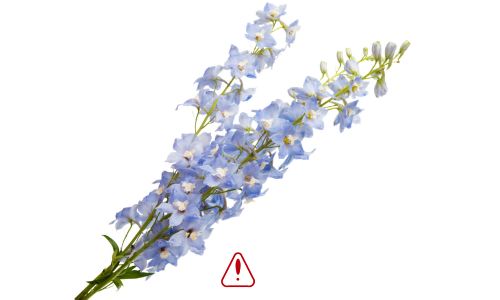Are Delphinium Perennials?
Discover the beauty of Delphiniums, the showstoppers of summer flower gardens! Learn how to plant, care for, and enjoy these vibrant perennials with their long spikes in gorgeous hues. Find out how to propagate them and create a stunning, bee-attracting garden. Delve into the wit and wisdom surrounding Delphiniums and uncover their secrets. Get ready to transform your garden with these charming blooms!

Are Delphinium Perennials?
All About Delphinium Flowers
Belonging to the Ranunculaceae family, delphinium is a distinctive genus. (It's often mistaken for larkspur, but they are different plant species.) With over 300 species, you'll find a wide range of heights, from charming dwarf hybrids to majestic 6-foot tall varieties, making them perfect for the front, middle, or back of your perennial border. While blue delphiniums are commonly seen, you'll also find them in enchanting shades of violet, pink, white, red, and purple. These beauties are well-loved in both cottage-style and cutting gardens.Most delphiniums are short-lived perennials, gracing the garden for about 2 to 3 years. However, with proper care, some varieties can bloom all summer long if you trim them regularly. Certain hybrids display their first flowers from early to mid-summer and offer a second show in late summer or early fall when you prune the old flower stalk.
The key to successful delphinium growing lies in meeting their specific requirements. These beauties prefer moist, cool summers and don't fare well in hot, dry weather or sudden bouts of wind and rain that can knock them down. To support their tall stems, most varieties will need staking. More details on this below.
Are Delphiniums Poisonous?

It's essential to be aware that delphiniums are highly poisonous. Ingesting their seeds and seedlings can lead to nausea, twitching muscles, paralysis, and even death. This is a particular concern for grazing animals like cattle, horses, and sheep, as well as a warning for gardeners with small children. Take extra precautions to ensure safety around these stunning yet toxic flowers.
How to Plant Delphinium?

Find a sunny spot with some protection from strong winds for your delphiniums. These plants have heavy flower spikes that grow on hollow stems, so it's essential to stake them early in the growing season to prevent breakage. The soil should be fertile, well-draining, and slightly alkaline (pH 6.0 to 7.5). Before planting, loosen the garden soil and mix in 2 to 4 inches of compost or aged manure. If necessary, perform a soil test and add lime, wood ashes, or a mix of the two to suit the preferences of this alkaline-loving perennial.
Step by Step:
• Dig a hole twice the diameter of the plant's container.
• Ensure that the top of the root ball is level with the surface of the soil.
• Fill the hole with soil and water thoroughly.
When to Plant Delphinium?
Plant delphiniums in the spring as transplants from a garden nursery. For indoor starting, sow seeds about 10 weeks before the last spring frost.
How to Grow Delphinium?
• Delphiniums are hungry plants and require regular feeding. Apply a balanced liquid fertilizer every 2 to 3 weeks, starting in early spring.
• Install sturdy stake supports before mid-spring or when the plants reach 12 inches in height.
• Keep the soil consistently moist, avoiding both dryness and excessive puddling. Water the plants during the summer if rainfall is less than 1 inch per week.
• To encourage ideal flower spikes, trim side shoots when they reach 3 inches high. Leave 2 or 3 shoots on young plants and 5 to 7 shoots on mature, well-established ones.
• After the delphiniums finish blooming, cut back the flower stalks to the ground. New, albeit smaller, flower stalks will develop, and the flowers can withstand chilly days and light frosts. (Check your local frost dates.)
• 3 to 4 years, divide the plants in spring: Remove and replant the new little plants growing around the outer edge of the clump. Discard the older, hard heart of the plant.
Did you know that...
• The term "delphinium" comes from the Greek word "delphis," which means "dolphin," as the closed flower buds were thought to resemble a dolphin's nose.
• The centers of delphinium flowers are playfully called "bees."
• If you're growing delphiniums from seed, don't lose hope. Use fresh seeds and place them in egg cartons with damp seed mix in the fridge. Once most of them have sprouted, move them under a bright light in a room with normal to cool temperatures.
Recent Posts
Year : 2024
Year : 2023
Year : 2021
Year : 2020

